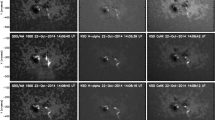Abstract
We study the solar flare of July 19, 2000 of M6.4/3N class, which occurred in the active region NOAA 9087. Echelle Zeeman spectrograms of this flare were obtained with the horizontal solar telescope of the Astronomical Observatory of Taras Shevchenko National University of Kyiv. Physical conditions were compared for two times corresponding to the pre-peak and peak phases of the flare in area of a small sunspot. It was found that the effective magnetic field \(B\)eff by Fe I 6301.5 and Fe I 6302.5 lines was almost the same for both times and both spectral lines. However, \(B\)eff in peak phase measured by the splitting of the emission peaks of Fe II and H\(\upbeta \) lines turned out to be 300–500 G stronger than those by the above-mentioned Fe I lines, whereas by D3 He I line it was found to be close to zero. This may indicate a local magnetic field increase in height range from temperature minimum region to the lower chromosphere. A semi-empirical model of the photospheric layers of the flare, constructed on a base of observations of Fe I 5123.7 and Fe I 5434.5 lines by solving the inverse problem for non-equilibrium radiative transfer using Tikhonov stabilizers, shows the moderate increasing of temperature (∼300 K) in altitude range 250–500 km. The radial velocities were decreased during peak phase. The micro-turbulent velocity was increased in the photosphere layers before the flare peak, while during the peak phase it was significantly decreased. The obtained results indicate that in the pre-peak phase the altitude perturbations in the photosphere were larger than in the peak phase.







Similar content being viewed by others
References
Abramenko, V.I., Yurchishin, V.B., Carbone, V.: Kinem. Fiz. Nebesnykh Tel 14, 210 (1998)
Babcock, H.W.: Astrophys. J. 118, 387 (1953)
Botygina, O., Gordovskyy, M., Lozitsky, V.: Astroinformatics. In: Proc. Int. Astron. Union, IAU Symp. vol. 325, p. 59 (2017)
Collados, M., Martínez Pillet, V., Ruiz Cobo, B., del Toro Iniesta, J.C., Vázquez, M.: Astron. Astrophys. 291, 622 (1994)
de la Cruz, R.J., Leenaarts, J., Asensio, R.A.: Astrophys. J. Lett. 830, 30 (2016)
Gordovskyy, M., Lozitsky, V.G.: Sol. Phys. 289, 3681 (2014)
Gordovskyy, M., Shelyag, S., Browning, P.K., Lozitsky, V.G.: Astron. Astrophys. 619, A164 (2018)
Hong, J., Ding, M.D., Li, Y., Carlsson, M.: Astrophys. J. Lett. 857, L2 (2018)
Jurčák, J., Kašparová, J., Švanda, M., Kleint, L.: Astron. Astrophys. 620, A183 (2018)
Khomenko, E., Collados, M.: Astrophys. J. 659, 1726 (2007)
Kondrashova, N.N.: Mon. Not. R. Astron. Soc. 431, 1417 (2013)
Kosovichev, A.G., Zharkova, V.V.: Sol. Phys. 190, 459 (1999)
Kuckein, C., Collados, M., Manso Sainz, R.: Astrophys. J. Lett. 799, L25 (2015)
Landi Degl’Innocenti, E.L.: Sol. Phys. 77, 285 (1982)
Liu, C., Deng, N., Lee, J., et al.: Astrophys. J. 795, 128 (2014)
Lozitsky, V.G.: Adv. Space Res. 55, 958 (2015)
Lozitsky, V.G.: Adv. Space Res. 57, 398 (2016)
Lozitsky, V.G., Stodilka, M.I.: J. Phys. Stud. 23(4), 4902 (2019)
Lozitsky, V.G., Baranovsky, E.A., Lozitska, N.I., Leiko, U.M.: Sol. Phys. 191, 171 (2000)
Lozitsky, V.G., Baranovsky, E.A., Lozitska, N.I., Tarashchuk, V.P.: Mon. Not. R. Astron. Soc. 477, 2796 (2018)
Lozitsky, V.G., Baranovsky, E.A., Lozitska, N.I., Tarashchuk, V.P.: Odessa Astron. Publ. 32, 125 (2019)
Maltby, P., Avrett, E.H., Carlsson, M., Kjeldseth-Moe, O., Kurucz, R.L., Loeser, R.: Astrophys. J. 306, 284 (1986)
Moore, Ch.E., Minnaert, M.G.J., Houtgast, J.: The Spectrum 2935 Å to 8770 Å. National Bureau of Standards, Washington (1966). Second revision of Rowland’s Table of solar spectrum wave lengths
Priest, E.R., Forbes, T.D.: Astron. Astrophys. Rev. 10, 313 (2002)
Rachkovsky, D.N., Tsap, T.T., Lozitsky, V.G.: J. Astrophys. Astron. 26, 1 (2005)
Ruan, G.P., Chen, Y., Wang, S., et al.: Astrophys. J. 784, 165 (2014)
Ruan, G., Chen, Y., Wang, H.: Astrophys. J. 812, 120 (2015)
Socas-Navarro, H.: Astrophys. J. Suppl. Ser. 169, 439 (2007)
Stenflo, J.O.: Sol. Phys. 32, 41 (1973)
Stodilka, M.I.: Kinem. Fiz. Nebesnykh Tel 19, 334 (2003)
Stodilka, M.I.: Kinem. Fiz. Nebesnykh Tel 21, 461 (2005)
Stodilka, M.I., Prysiazhnyi, A.I.: Kinemat. Phys. Celest. Bodies 32, 23 (2016)
Sudol, J.J., Harvey, J.W.: Astrophys. J. 635, 647 (2005)
Suematsu, Y., Tsuneta, S., Ichimoto, K., Shimizu, T., et al.: Sol. Phys. 249, 197 (2008)
Wang, H.M., Liu, C.: Astrophys. J. Lett. 716, L195 (2010)
Wang, S., Liu, C., Liu, R., et al.: Astrophys. J. Lett. 745, L17 (2012)
Zemanek, E.N., Stefanov, A.P.: Vestn. Kiev. Univ., Ser. Astron. 18, 20 (1976)
Acknowledgements
The authors are grateful to an unknown reviewer for useful advices and critical comments. This study was funded by the Taras Shevchenko National University of Kyiv, project No. 19БФ023-03, and by the Ivan Franko National University of Lviv, project No. AO91-F.
Author information
Authors and Affiliations
Corresponding author
Ethics declarations
Conflict of Interest
The authors declare that they have no conflict of interest.
Additional information
Publisher’s Note
Springer Nature remains neutral with regard to jurisdictional claims in published maps and institutional affiliations.
Rights and permissions
About this article
Cite this article
Lozitsky, V.G., Stodilka, M.I. Comparison of physical conditions in two phases of the solar flare of July 19, 2000 of M6.4/3N class. Astrophys Space Sci 366, 30 (2021). https://doi.org/10.1007/s10509-021-03935-5
Received:
Accepted:
Published:
DOI: https://doi.org/10.1007/s10509-021-03935-5




